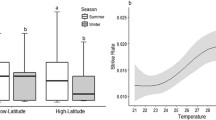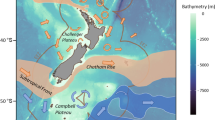Abstract
The common sea star, Asterias rubens, is a major predator in rocky subtidal ecosystems in the northern Gulf of St. Lawrence and along the Atlantic coasts of Nova Scotia and Newfoundland, Canada. We carried out two laboratory experiments to test the effects of water temperature, starvation, and body size, on mussel (Mytilus edulis) consumption and size selection in A. rubens from southeastern Newfoundland. Experiment 1 examined rates of consumption of medium (15–30 mm) mussels by small (9–15 cm) sea stars fed or starved moderately (for 3 weeks) at three temperatures representative of late summer highs (8, 11, and 15 °C) and one temperature representative of late winter lows (2 °C). Temperature and starvation did not affect consumption in summer, which was two times higher than in winter. Starvation also did not affect consumption in winter. Experiment 2 examined consumption of small (5–15 mm), medium, and large (30–45 mm) mussels by small and large (25–30 cm) sea stars fed or starved moderately or severely (for 6 weeks). Small sea stars consumed similar proportions of mussels regardless of starvation. However, large, moderately starved sea stars consumed at least two times more mussels than large, fed and large, severely starved individuals, indicating that the need to feed after a short starvation was higher in large than small A. rubens. Consumption of small, medium, and large mussels was, respectively, affected by the sea star’s size only, size and starvation independently, and size and starvation interactively. Collectively, our findings indicate that starvation, body size, and their interaction are key modulators of feeding in A. rubens, while suggesting that feeding is adaptable to thermal conditions. They also speak of the importance of considering the interplay between organismal traits and ongoing changes in ocean climate to better predict causes and consequences of alterations in predator–prey interactions.



Similar content being viewed by others
References
Aguera A, Trommelen M, Burrows F, Jansen JM, Schellekens T, Smaal A (2012) Winter feeding activity of the common starfish (Asterias rubens L.): the role of temperature and shading. J Sea Res 72:106–112
Anger K, Rogal U, Schriever G, Valentin C (1977) In-situ investigations on Echinoderm Asterias rubens as a predator of soft-bottom communities in Western Baltic Sea. Helgol Wiss Meeresunters 29:439–459
Barbeau MA, Scheibling RE (1994a) Temperature effects on predation of juvenile sea scallops [Placopecten magellanicus (Gmelin)] by sea stars (Asterias vulgaris Verrill) and crabs (Cancer irroratus Say). J Exp Mar Biol Ecol 182:27–47
Barbeau MA, Scheibling RE (1994b) Behavioral mechanisms of prey size selection by sea stars (Asterias vulgaris Verrill) and crabs (Cancer irroratus Say) preying on juvenile sea scallops (Placopecten magellanicus (Gmelin)). J Exp Mar Biol Ecol 180:103–136
Begon M, Harper JL, Townsend CR (2014) Essentials of ecology, 4th edn. Blackwell Science, Oxford
Blain C, Gagnon P (2013) Interactions between thermal and wave environments mediate intracellular acidity (H2SO4), growth, and mortality in the annual brown seaweed Desmarestia viridis. J Exp Mar Biol Ecol 440:176–184
Bolker BM, Brooks ME, Clark CJ, Geange SW, Poulsen JR, Stevens MHH, White JSS (2008) Generalized linear mixed models: a practical guide for ecology and evolution. Trends Ecol Evol 24:127–135
Brockington S, Clarke A (2001) The relative influence of temperature and food on the metabolism of a marine invertebrate. J Exp Mar Biol Ecol 258:87–99
Brown JH, Gillooly JF, Allen AP, Savage VM, West GB (2004) Toward a metabolic theory of ecology. Ecology 85:1771–1789
Chia FS (1969) Histology of pyloric caeca and its changes during brooding and starvation in a starfish Leptasterias hexactis. Biol Bull 136:185–192
Clark AMG, Downey ME (1992) Starfishes of the Atlantic. Chapman & Hall, New York
Dahlhoff EP, Buckley BA, Menge BA (2001) Physiology of the rocky intertidal predator Nucella ostrina along an environmental stress gradient. Ecology 82:2816–2829
Dahlhoff EP, Stillman JH, Menge BA (2002) Physiological community ecology: variation in metabolic activity of ecologically important rocky intertidal invertebrates along environmental gradients. Integr Comp Biol 42:862–871
Dare PJ (1982) Notes on the swarming behavior and population density of Asterias rubens L. (Echinodermata, Asteroidea) feeding on the mussel, Mytilus edulis L. J Cons 40:112–118
Emlen JM (1966) The role of time and energy in food preference. Am Nat 100:611–617
Frey DL, Gagnon P (2015) Thermal and hydrodynamic environments mediate individual and aggregative feeding of a functionally important omnivore in reef communities. PLoS ONE 10(3):e0118583
Gagnon P, Blain C, Vad J (2013) Living within constraints: irreversible chemical build-up and seasonal temperature-mediated die-off in a highly acidic (H2SO4) annual seaweed (Desmarestia viridis). Mar Biol 160:439–451
Gaymer CF, Himmelman JH (2002) Mussel beds in deeper water provide an unusual situation for competitive interactions between the seastars Leptasterias polaris and Asterias vulgaris. J Exp Mar Biol Ecol 277:13–24
Gaymer CF, Himmelman JH, Johnson LE (2001a) Use of prey resources by the seastars Leptasterias polaris and Asterias vulgaris: a comparison between field observations and laboratory experiments. J Exp Mar Biol Ecol 262:13–30
Gaymer CF, Himmelman JH, Johnson LE (2001b) Distribution and feeding ecology of the seastars Leptasterias polaris and Asterias vulgaris in the northern Gulf of St Lawrence, Canada. J Mar Biol Assoc UK 81:827–843
Gaymer CF, Himmelman JH, Johnson LE (2002) Effect of intra- and interspecific interactions on the feeding behavior of two subtidal sea stars. Mar Ecol Prog Ser 232:149–162
Gaymer CF, Dutil C, Himmelman JH (2004) Prey selection and predatory impact of four major sea stars on a soft bottom subtidal community. J Exp Mar Biol Ecol 313:353–374
Gillooly JF, Brown JH, West GB, Savage VM, Charnov EL (2001) Effects of size and temperature on metabolic rate. Science 293:2248–2251
Hancock DA (1958) Notes on starfish on an Essex oyster bed. J Mar Biol Assoc UK 37:565–589
Harley CD (2013) Linking ecomechanics and ecophysiology to interspecific interactions and community dynamics. Ann N Y Acad Sci 1297:73–82
Hart LJ, Chia F-S (1990) Effect of food supply and body size on the foraging behavior of the burrowing sea urchin Echinometra mathaei (de Blainville). J Exp Mar Biol Ecol 135:99–108
Himmelman JH, Dutil C (1991) Distribution, population-structure and feeding of subtidal seastars in the Northern Gulf of St-Lawrence. Mar Ecol Prog Ser 76:61–72
Himmelman JH, Steele DH (1971) Foods and predators of the green sea urchin Strongylocentrotus droebachiensis in Newfoundland waters. Mar Biol 9:315–322
Himmelman JH, Dutil C, Gaymer CF (2005) Foraging behavior and activity budgets of sea stars on a subtidal sediment bottom community. J Exp Mar Biol Ecol 322:153–165
Hummel C, Honkoop P, van der Meer J (2011) Small is profitable: no support for the optimal foraging theory in sea stars Asterias rubens foraging on the blue edible mussel Mytilus edulis. Estuar Coast Shelf Sci 94:89–92
Jangoux M, van Impe E (1977) Annual pyloric cycle of Asterias rubens L (Echinodermata Asteroidea). J Exp Mar Biol Ecol 30:165–184
Johnstone I, Norris K (2000) Not all Oystercatchers Haematopus ostralegus select the most profitable Common Cockles Cerastoderma edule: a difference between feeding methods. Ardea 88:137–153
Juanes F, Hartwick EB (1990) Prey size selection in Dungeness crabs: the effect of claw damage. Ecology 71:744–758
Killen SS, Brown JA, Gamperl A (2007) The effect of prey density on foraging mode selection in juvenile lumpfish: balancing food intake with the metabolic cost of foraging. J Anim Ecol 76:814–825
Killen SS, Marras S, McKenzie DJ (2011) Fuel, fasting, fear: routine metabolic rate and food deprivation exert synergistic effects on risk-taking in individual juvenile European sea bass. J Anim Ecol 80:1024–1033
MacArthur RH, Pianka ER (1966) On optimal use of a patchy environment. Am Nat 100:603–609
McClintock J, Lawrence J (1985) Characteristics of foraging in the soft-bottom benthic starfish Luidia clathrata (Echinodermata: Asteroidea): prey selectivity, switching behavior, functional responses and movement patterns. Oecologia 66:291–298
McCullagh P, Nelder JA (1989) Generalized linear models, 2nd edn. Chapman & Hall, New York
Menge BA (1982) Effects of feeding on the environment—Asteroidea. In: Jangoux M, Lawrence JM (eds) Echinoderm nutrition. A. A. Balkema, Rotterdam, pp 521–551
Menge BA, Sutherland JP (1987) Community regulation—variation in disturbance, competition, and predation in relation to environmental stress and recruitment. Am Nat 130:730–757
Nichols D, Barker MF (1984) Growth of juvenile Asterias rubens L (Echinodermata-Asteroidea) on an intertidal reef in Southwestern Britain. J Exp Mar Biol Ecol 78:157–165
Okumuş İ, Stirling HP (1998) Seasonal variations in the meat weight, condition index and biochemical composition of mussels (Mytilus edulis L.) in suspended culture in two Scottish sea lochs. Aquaculture 159:249–261
Pinet PR (2011) Invitation to oceanography. Jones & Bartlett Learning, Burlington
Raymond J-F, Himmelman JH, Guderley HE (2007) Biochemical content, energy composition and reproductive effort in the broadcasting sea star Asterias vulgaris over the spawning period. J Exp Mar Biol Ecol 341:32–44
Robles C, Sherwoodstephens R, Alvarado M (1995) Responses of a key intertidal predator to varying recruitment of its prey. Ecology 76:565–579
Rochette R, Hamel JF, Himmelman JH (1994) Foraging strategy of the asteroid Leptasterias polaris—role of prey odors, current and feeding status. Mar Ecol Prog Ser 106:93–100
Scheibling RE, Lauzon-Guay JS (2007) Feeding aggregations of sea stars (Asterias spp. and Henricia sanguinolenta) associated with sea urchin (Strongylocentrotus droebachiensis) grazing fronts in Nova Scotia. Mar Biol 151:1175–1183
Scheiner MS, Gurevitch J (2001) Design and analysis of ecological experiments. Oxford University Press, New York
Schiel DR, Steinbeck JR, Foster MS (2004) Ten years of induced ocean warming causes comprehensive changes in marine benthic communities. Ecology 85:1833–1839
Siddon CE, Witman JD (2003) Influence of chronic, low-level hydrodynamic forces on subtidal community structure. Mar Ecol Prog Ser 261:99–110
Sloan NA (1980) Aspects of the feeding biology of asteroids. Oceanogr Mar Biol Annu Rev 18:57–124
Sloan NA, Aldridge TH (1981) Observations on an aggregation of the starfish Asterias rubens L. in Morecambe Bay, Lancashire, England. J Nat Hist 15:407–418
Smallegange IM, Van der Meer J (2003) Why do shore crabs not prefer the most profitable mussels? J Anim Ecol 72:599–607
Snedecor GW, Cochran WG (1989) Statistical methods, 8th edn. Iowa State University Press, Ames
Sokal RR, Rohlf FJ (2012) Biometry; the principles and practices of statistics in biological research. W. H. Freeman and Co., New York
Sommer U, Meusel B, Stielau C (1999) An experimental analysis of the importance of body-size in the seastar-mussel predator-prey relationship. Acta Oecol 20:81–86
St-Pierre AP, Gagnon P (2015) Wave action and starvation modulate intra-annual variation in displacement, microhabitat selection, and ability to contact prey in the common sea star, Asterias rubens Linnaeus. J Exp Mar Biol Ecol 467:95–107
Valentinčič T (1973) Food finding and stimuli to feeding in the sea star Marthasterias glacialis. Neth J Sea Res 7:191–199
Wong MC, Barbeau MA (2005) Prey selection and the functional response of sea stars (Asterias vulgaris Verrill) and rock crabs (Cancer irroratus Say) preying on juvenile sea scallops (Placopecten magellanicus (Gmelin)) and blue mussels (Mytilus edulis Linnaeus). J Exp Mar Biol Ecol 327:1–21
Xu RA, Barker MF (1990) Laboratory experiments on the effects of diet on the gonad and pyloric caeca indices and biochemical composition of tissues of the New Zealand starfish Sclerasterias mollis (Hutton) (Echinodermata: Asteroidea). J Exp Mar Biol Ecol 136:23–45
Zandee DI, Kluytmans JH, Zurburg W, Pieters H (1980) Seasonal variations in biochemical composition of Mytilus edulis with reference to energy metabolism and gametogenesis. Neth J Sea Res 14:1–29
Acknowledgments
We are grateful to D. Bélanger, D. Frey, K. Millar, P. Schryburt, L. Purchase, R. Roberts, Í. Lima, and M. Valliant for help with field and laboratory work. We also thank two anonymous reviewers for constructive comments that helped improve the manuscript. This research was funded by Natural Sciences and Engineering Research Council of Canada (NSERC Discovery Grant), Canada Foundation for Innovation (CFI-Leaders Opportunity Funds), and Research & Development Corporation of Newfoundland and Labrador (IngniteR&D) grants to P. Gagnon. A. P. St-Pierre was supported by the NSERC Canada Graduate Scholarship-Master’s Program and the Fond de recherche du Québec - Nature et technologies (FRQNT) Masters research scholarship—B1 program.
Author information
Authors and Affiliations
Corresponding author
Additional information
Communicated by M. Byrne.
Rights and permissions
About this article
Cite this article
St-Pierre, A.P., Gagnon, P. Effects of temperature, body size, and starvation on feeding in a major echinoderm predator. Mar Biol 162, 1125–1135 (2015). https://doi.org/10.1007/s00227-015-2655-3
Received:
Accepted:
Published:
Issue Date:
DOI: https://doi.org/10.1007/s00227-015-2655-3




